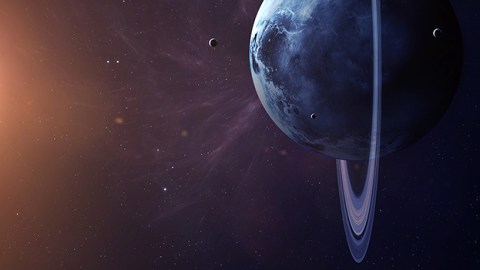Uranus’ Strange Magnetosphere Switches Open and Closed, Letting in Solar Wind

Uranus has a “switch-like” magnetosphere that opens and closes once every rotation of the planet, exposing it to deadly solar winds, according to researchers at the Georgia Institute of Technology in the US.
The findings could help scientists understand the mechanics of distant systems, and refine the ways they search for alien life.
First, what exactly is a magnetosphere?
A magnetosphere is the region of space around an object in which charged particles are controlled by that object’s magnetic field. Earth’s magnetosphere shields us from the solar wind – the continual stream of charged particles that flows from the upper atmosphere of the sun – by deflecting the radiation. Without a magnetosphere, radiation would destroy Earth’s atmosphere and make it impossible for life and liquid water to exist.
Here’s an artists’ rendering of Earth’s magnetosphere:
Earth’s magnetosphere remains stable because it lines up closely with its axis, which tilts at about 23 degrees.
Uranus is unlike any other planet in our solar system. It tilts at about 98 degrees, effectively rolling on its side as it rotates the sun. Uranus’ magnetosphere, however, tilts at 60 degrees relative to the planet’s axial tilt, causing it “to spin around like a top that’s about to topple.”
This discrepancy makes the magnetosphere unstable, causing it switch “open” and “closed” once every Uranus day, which lasts 17 hours and 14 minutes.
Uranus’ magnetosphere deflects the solar wind like an umbrella when it’s closed. But when it opens, charged particles rush in and bombard the planet.
“Uranus is a geometric nightmare,” said Carol Paty, an associate professor at Georgia Institute of Technology. “The magnetic field tumbles very fast, like a child cartwheeling down a hill head over heels. When the magnetized solar wind meets this tumbling field in the right way, it can reconnect and Uranus’s magnetosphere goes from open to closed to open on a daily basis.”
(This .gif shows Uranus’ magnetosphere switching between “closed” and “open”)
Occasionally, Earth’s magnetosphere allows in a tiny amount of the solar wind, causing auroras to appear in the sky. But it’s nothing compared to Uranus, where researchers suggest there could be spectacular auroras appearing above the ice giant every day.
(Photo: Northern Lights in Norway by Dean Mouhtaropoulos)
Scientists have known about Uranus’ strange magnetosphere since the Voyager 2 flew by the planet and collected data in 1986. But no one had quite understood the planet’s rotation in this way until Paty and Xin Cao published their paper in the Journal of Geophysical Research: Space Physics.
(Uranus as viewed by Voyager 2)
The findings could help scientists make predictions about the mechanics of distant systems beyond Uranus.
“Looking at how Uranus’s complicated, strange magnetosphere works helps us understand how all the other systems work,” George Hospodarsky at the University of Iowa told New Scientist. “It’s sort of like doing an experiment one way and then turning it upside down and starting again. If it still works, your theories are good.”
Scientists could also use the research to hone their search for alien life.
“The majority of exoplanets that have been discovered appear to also be ice giants in size,” said Cao, who led the study. “Perhaps what we see on Uranus and Neptune is the norm for planets: very unique magnetospheres and less-aligned magnetic fields. Understanding how these complex magnetospheres shield exoplanets from stellar radiation is of key importance for studying the habitability of these newly discovered worlds.”





